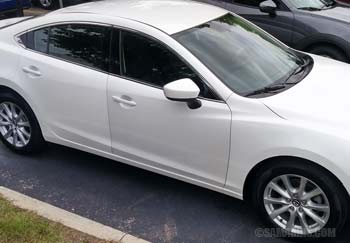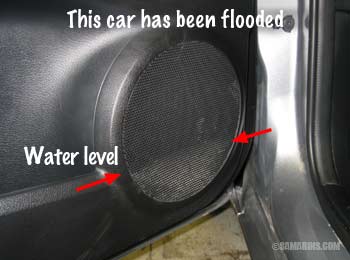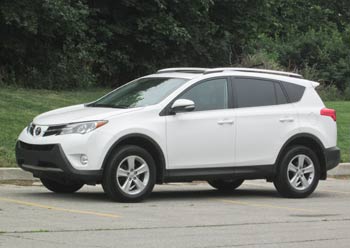Signs of previous accident repairs or a paint job in a used car
By Vlad Samarin, Updated: September 16, 2023
We have seen many used cars that have been restored after accidents on the used car market. Some dealers will disclose previous collisions, some might not even be aware. There are 3 steps to check if the used car has been involved in an accident:
- Check the used car history records. Many accidents (but not all) are reported and the used car history report may show this.
- Inspect a car body for signs of accident or rust repairs; see photos below.
- Have the used car properly inspected by a knowledgeable mechanic or a used car inspector before signing the deal.
Check if the panels are lined up, look at the side reflection
| Look at the reflection. For example, this car looks like new. The lines are straight, the fender and doors are lined up and the paint looks consistent and smooth. Click on the photo to see a larger image. |
| Here, you can see some unevenness on the rear fender in the reflection. It looks like there was a collision repair. |
| As we looked closer at this rear fender, we found this: the clear coat is peeling off. It's a sure sign of a paint job. |
| The rear corner of this truck has been repaired. As you can see, the reflection doesn't look smooth. Click on the photo, see the area under the gas tank lid and in the corner near the taillight. |
Check how body panels fit together
| See how different body panels fit together. The hood, doors and the trunk, when closed should be properly aligned with other panels. Look at this car, the rear door is misaligned; there has been some body repair here. |
| The corner of the front bumper is loose in this car. If you look closer, the bumper color is different too. It looks like there was a body repair in this corner. If you notice something like this, the area should be inspected closely. |
| In this car, the front passenger door is not closing smoothly. You can tell that the front door is not aligned properly. Is it because of previous accidents or because hinges are worn out and rusted? After a closer inspection we found that this car has been involved in a frontal accident. |
Check if the color of different panels match
The trick is to look from the distance and from different angles. This way it's easier to spot the difference. Look from different angles, see the next photo. Look from different angles, see the next photo. |
| Can you spot the difference now? You are right, that door has a different shade, it has been painted. This happens because it's difficult to precisely match the original paint color when repainting, although top body shops do a better job. |
| Look at this car, does the front bumper look a little different than the rest of the car? You are right, it's darker because it has been repainted. |
Compare opposite sides
| Here is a trick: if something doesn't look right, compare it to another side. For example, this Pontiac Vibe was offered for sale at a new car dealership. A salesperson told us that they just got this car. While checking, we found that the gap between the front fender and the door looks wide on the right side. |
| Checking the left side showed a different picture; the gap is almost non-existent as you can see. After further inspection we found that this car has been sideswiped, so its entire front end has shifted to one side. |
| We checked this black Toyota at another dealership. The salesperson was honest and mentioned that the vehicle has been in a minor accident, the price was low too. We opened the hood and it was easy to see. Compare these two photos; can you spot which side has been damaged? This is the left front fender. |
| This is the right front fender. This corner appears to have been hit. Look at the area around those two bolts holding the fender. If you look closely (click on the photo), you can see the paint quality is poor too. |
Check the headlights
| Do any of the headlights or taillights have a moisture inside? This often happens when water penetrates into the headlight through a crack or a missing bulb cover. Has this corner been hit? Inspect it carefully. This headlight will need to be replaced, and it's not cheap. |
|
Compare both headlights (and taillights). If one headlight looks old and the other looks new, it's possible that the new headlight has been installed recently. Was it during a collision repair? Look at this Honda Civic. The left headlight is old (original), but the right headlight looks new. It even has a different manufacturer marking. After a close inspection we found that the right front corner has been hit, although the damage was minor. |
Watch out for difference in the paint texture
| Look at the quality and texture of the paint. A fresh paint may have a different texture. Signs of sanding during a body repair are also often visible through the paint. In this photo you can clearly see sanding marks under the paint. This is a clear sign of a body repair. Click on the photo to see the larger image. |
| The paint texture of this door doesn't look right, you can see this in the reflection. There was some body repair here. Feel the paint surface with your hand. The original paint finish should be smooth, while the repainted panels may feel a bit rough and uneven, like an orange peel. |
Look for paint overspray
| At the car assembly plant, the body is painted before anything is installed on it. This means that any plastic trim or wiring should not be painted over. Here you can see that the door wiring harness boot shows a white paint overspray, which is an indication of a paint job. |
Look for peeling paint
| A peeling-off paint is another indicator of a poorly-done paint job. Often you can see a paint peeling off of one of the bumpers. |
Check the bolts that hold the hood
| Here is another tip: when you open the hood, check the bolts that hold it. Do they look like they have never been touched? Here you can clearly see that this bolt has been tampered with. This means that the hood was either replaced or readjusted from its original position. |
|
To compare, look at this car, the nuts that hold the hood look like they haven't been touched. This hood is original. Many cars have a sticker attached to the hood. This car in the photo has an original sticker. If the sticker is missing or looks like it was re-attached, it's possible that the hood has been replaced. |
Check the frame if it's a pickup truck
| The frame is what holds the truck together. Is it badly rusted? Does it shows sings of wielding or other repair? Take a photo or video with your phone if it's not visible. The frame in this truck looks OK. How does the truck bed look from underneath? We have seen many pickup truck where a bedliner was there to cover rusted through holes in the bed. |
Avoid previously flooded cars
| Avoid used cars that have been flooded. A flooded vehicle is more likely to develop various electrical problems and mold in the future. Flash floods are very common these days. This car looks fairly clean and runs good, but something doesn't look right about this speaker cover. It shows a dirty water level mark. Was this car flooded? |
| We removed the rear trim piece from the center console to confirm. There's no questions this car has been flooded. You can see the water level marks on the inside of the trim piece. This car should be avoided. A vehicle history report can also reveal a previous flood damage. Be suspicious if the history report indicates that the car came from a recent flood zone. |
Is it OK to buy a car that has rust damage?
The rust is a major issue in used cars, especially the ones that have been driven where salt is used on the roads in winter months. Unless the car has been properly rust-proofed, any 7-10 year old and older car or truck from the Rust Belt will show some rust. Rust damage can be repaired temporarily, but once the corrosion process is started, it's very difficult to stop. The metal used in modern cars is better, but rust problems have not been eliminated. If a car had major rust spots repaired, the rust will re-appear later. More importantly, if the body shows rust on the outside, the underneath parts are more likely badly rusted too. Check, for example, these brake lines, or this subframe. Both are a safety concern. For this reason, the cars that show major rust should be avoided.Where does the rust usually start? You are more likely to find rust at the bottom edges of the doors and around the wheel wells. In this car, it's just starting, but in a few years this door will look bad if not treated. This rust spot has already been repaired and now the rust shows again. If you suspect a repaired rust spot, try sticking a small magnet; it won't stick if there is too much filler over the metal.
These transmission cooler lines are badly rusted, but you won't see them from the outside. In this car, they are hidden behind the spash guard, under the radiator.
Advertisement
Should you buy a car that has been in an accident? Unless it was a minor fender-bender like in this photo, we don't recommend it. We don't want to say that a damaged car cannot be restored to a like-new condition; there are plenty of collision repair shops that do an excellent job. The problem is that for an average buyer it's difficult to tell if a car has been repaired to the highest standards or was "patched up" for a quick sale.
This means that buying a car that has been restored after a serious accident is taking a chance. Were repairs done properly or the rust spots will appear after a year or two? Will the paint peel away or fade? Has the wheel alignment been done right or the tires will be wearing fast? Will the air conditioner still work after a few months? Was the front-sensing camera re-calibrated after windshield replacement?
Read Next:
Signs of automatic transmission problems when test driving a used car
How to check an engine when buying a used car
How to inspect a used car?
Buying a Used Car: 10 Common Mistakes to Avoid
Should you buy a turbocharged car?
What mileage is OK for a used car?
Reviews of popular used cars including problems to watch out for.
Reviews of popular used SUVs.
Signs of automatic transmission problems when test driving a used car
How to check an engine when buying a used car
How to inspect a used car?
Buying a Used Car: 10 Common Mistakes to Avoid
Should you buy a turbocharged car?
What mileage is OK for a used car?
Reviews of popular used cars including problems to watch out for.
Reviews of popular used SUVs.

























